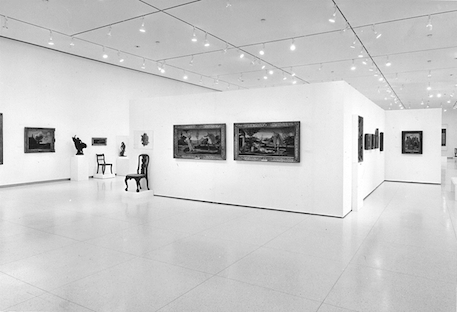European Art
August 16, 2016–June 25, 2017

Above: Installation view of the Smart's collection of European art.
Top: Daphne Found Asleep by Apollo (detail), c. 1500, Oil, formerly on panel, transferred to canvas. Smart Museum of Art, The University of Chicago, Gift of the Samuel H. Kress Foundation, 1973.44.
The Smart Museum’s European collection ranges from antiquity to the nineteenth century, with particular strengths in works on paper as well as Renaissance painting, sculpture, and decorative arts.
The works on view in 2016–2017 explore key themes, movements, and artistic approaches in European art. Within a broad swath of history and geography, the groupings open deeper lines of inquiry into materials and craftmanship, the painted sketch, innocence and vulnerability, mythological and biblical narratives, and images of community and belonging.
Collection rotations
A small area of the gallery is dedicated to thematic displays of prints and drawings, often presented in connection with University of Chicago courses. These installations rotate every four months to protect the works from damage caused by long-term exposure to light.
The gallery also features an ongoing display that pairs a page from Francisco de Goya’s album Disasters of War with a plate from Jacques Callot’s Large Miseries of War.
Art History 101: Introduction to Art
September 17–December 10, 2016
Presented in conjunction with Art 101, the introductory art history course offered at the University of Chicago, this display gathers diverse works relating to the theme of presentation and self-representation. Accordingly, an Albrecht Dürer print of the “Veronica cloth” bearing the image of Christ’s face is juxtaposed with an anonymous “subway portrait” by Walker Evans; a self-portrait by painter Raphael Soyer shares the space with a self-reflexive photograph by Laura Letinsky; and H. C. Westermann’s autobiographical Korea sculpture stands in as a reminiscence of his service in that war.
Art History 101: Introduction to Art
December 20, 2016–March 19, 2017
Presented in conjunction with Art 101, the introductory art history course offered at the University of Chicago, this display gathers landscape works from Asian, American, and European cultures, spanning the seventeenth to the twentieth centuries. They are executed in a surprising variety of media—from two-dimensional scrolls, prints, and watercolor drawings to a faience plaque and even a cast-metal construction.
Claude Lorrain, Richard Earlom, and the Liber Veritatis
December 20, 2016–March 19, 2017
A selection of six mezzotints by Richard Earlom after drawings of Italian landscapes and Roman ruins by Claude Lorrain.
Ephemeral Museum
March 14–26, 2017
The winter 2017 art history course Rethinking the Social History of Art considers ways art relates to the world, from reflecting the views of particular people and classes to participating in religious practice and social critique. What role does the museum, and museum display, play in our understanding of these shifting roles? For this small pop-up exhibition, course participants have chosen seven objects to illuminate and argue art’s social and political stakes. They run the gamut of artistic media ranging from sculpture, photography, and architectural decoration to advertising poster and the comic book. The accompanying wall labels are the work of small groups of course participants, in consultation with Smart Museum staff. The project invites visitors to reflect on the mechanisms of museum communication: who writes the wall labels, and to what purpose? Where do we modern interpreters stand with respect to the objects we explain? Can we do justice to them? And do they continue to play a role in our lives?
Presented in the Edward A. and Inge Maser Gallery









